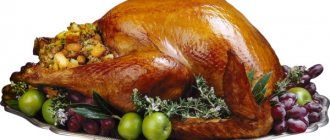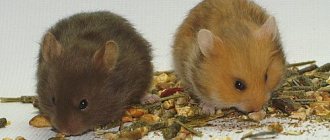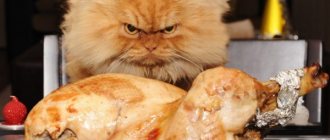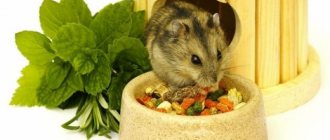The pug breed is distinguished not only by its compact size and original appearance, but also by physiological characteristics (for example, increased sensitivity of the gastrointestinal tract and a tendency to obesity), so a competent approach is important when creating a diet.
Which products are most preferable for this breed, and which, on the contrary, are undesirable? What is the daily food requirement of a pug (adult and puppy) and what should you pay attention to when choosing dry food?
Natural food at home
Regardless of the dog's age, properly selected and prepared food is essential to keeping your pet healthy and active. So, natural nutrition includes:
- Lean, high-quality meat and offal (mostly lean beef, chicken backs and wings - 100 - 200 grams up to 2 times a day).
- Milk and fermented milk products (especially cottage cheese - in the amount of 75 - 100 g of the total diet).
- Raw sea fish fillet (boneless). The daily norm is 100 - 200 g.
- Well-cooked porridge (buckwheat, oatmeal, rice) with the addition of minced meat, herbs, vegetables and fruits.
- Canned fish (pink salmon, mackerel, etc.).
- Fruits (apples, bananas, etc.) and vegetables (zucchini, broccoli, carrots, cucumbers, bell peppers, etc.).
- Greens (lettuce, dill, etc.).
According to dog breeders, natural food should consist of approximately 70% meat/fish products and the remaining 30% from cereals, fresh vegetables and fruits, as well as milk and dairy products.
It is also worth noting that if your pet is fed exclusively natural food, the animal’s body may not receive enough of some important vitamins and microelements. Therefore, it is necessary to additionally introduce vitamin and mineral complexes into the diet (for example, Hokamix30, Beaphar Duo Active Pasta, etc.).
Need for nutrients and vitamins
There can be two feeding options - dry mixtures or natural products. With the second method, the owner will have to put in a little more time and effort.
Knowing the daily requirement for minerals for a puppy and an adult pug (1 g of substance per 1 kg of weight) will help you understand what products should be present in a pug’s diet:
- carbohydrates – 10 and 6 g;
- proteins – 30 and 15 g;
- fats – 2.6 and 1.3 g;
- calcium – 0.5 g and 0.25 g;
- phosphorus, potassium – 0.4 g and 0.2 g;
- iron – 0.13 g for both puppies and adult dogs;
- magnesium – 0.02 g and 0.01 g.
Don't forget about vitamins. Vitamin A is responsible for the growth and development of organs, skeleton, and muscles. Necessary for pregnant and lactating dogs. Contained in greens (dill, spinach, parsley), fish oil and liver, egg yolks, milk, yellow, red and orange vegetables and fruits (apricots, pumpkin, tomatoes).
Vitamin B ensures healthy muscle development and normal appearance. Contained in liver, bran, greens, dried fruits, nuts, tomatoes, buckwheat.
Vitamin C strengthens the immune system, prevents the development of dental diseases, and ensures good functioning of the musculoskeletal system. Present in berries (currants), fruits, citrus fruits, sweet yellow and red peppers, broccoli and Brussels sprouts, and greens.
What is possible and what is not?
Permitted products include:
- Lean meats (beef, chicken, turkey, duck, rabbit).
- Milk and fermented milk products (kefir, yogurt, low-fat cottage cheese).
- Fresh vegetables, fruits, berries, a variety of greens.
- Fish (both canned and fresh).
- Various cereals (except corn and legumes).
- Fruits, vegetables, herbs.
- Industrial dry food.
It is advisable to serve fresh vegetables and herbs in chopped form.
It is recommended to exclude the following range of foods from your pug’s diet:
- Flour products made from white flour (in any form).
- Various semi-finished products.
- Raw eggs.
- Sour cream, cream and mayonnaise.
- Spices, seasonings, ketchup, sauces and marinades.
- Smoked products.
- Ice cream, candy, chocolate, cakes and any foods high in sugar (including those with sweetener).
- Fatty meat (especially pork).
- Potatoes (both fried and boiled).
- Corn and legumes (including soybeans).
- Mushrooms (in any form).
- Sausages, frankfurters and small sausages.
- Sharp and tubular bones.
- Citrus fruits (oranges, lemons).
- Raisins and grapes.
- Pasta.
- Porridge made from wheat and semolina.
- Any fried foods.
List of food items
Your pet's diet must include:
- Tangerines, apples, bananas (half or 1 small fruit per day, at the dog’s request).
- Dates and dried apricots (1 - 2 pieces per day).
- Porridge (preferably buckwheat, oatmeal or rice).
- Boiled eggs (2 - 3 pieces per week).
- Low-fat milk.
- Greens and vegetables (in small quantities every day, for example, as a side dish to the main dish).
- Brown bread (1 slice per day is allowed, for example, with butter or cheese).
- Cottage cheese (except for sweet curds with fillings).
Sometimes you are allowed to pamper your pet with a small piece of salted fish.
Puppies from 1 to 3 months
For the first morning feeding, puppies are given kefir, low-fat cottage cheese, and yogurt. To make your baby eat these foods more willingly, very little honey is added to dairy products.
For the second feeding, puppies should prepare lightly stewed vegetables with the addition of a small amount of salt (a few crystals). You can diversify the dish with well-cooked buckwheat or rice porridge, a small piece of black bread with cheese and butter.
Lunch and dinner must be meat. At the same time, babies are given bones that have been previously soaked in milk and beaten. From one to three months of age, puppies are fed five times a day. Give your pet a clove of garlic twice a week, which is an excellent preventative against many diseases.
How much food should I give?
The daily diet of an adult dog and a puppy are somewhat different from each other (the younger the age, the more often the animal needs to be fed, and vice versa).
Adult dog diet
It is recommended to feed an adult pug 2 - 3 times a day. So, to prepare porridge you will need:
- Cereals (approximately 30%);
- Lean meat (30%);
- Vegetables or herbs (about 30%);
- A small amount of vegetable oil.
In this case, the porridge must be served warm.
You can also feed your pet broth made from lean meats.
Puppy
Depending on the age, the puppy (up to a year) should be fed as follows:
- Up to 2 months - up to 6 times a day.
- From 2 to 4 months - 4 times a day.
- From 4 to 6 months - 3 times a day.
- From 6 to 10 months - 2 times a day.
The first complementary foods can be started from 1 to 1.5 months (low-fat kefir, cottage cheese).
Next, it is recommended to gradually introduce porridge with vegetables into the puppy’s diet. The transition to fish and meat dishes should be smoothly carried out from 3 months of age. From the age of one year, the dog is considered an adult.
As for the amount of food, the calculation is made based on the weight of the dog (5 - 7% of the total weight).
For example, if a puppy weighs 8 kg, then the daily norm should be at least 400 grams (5%). In turn, the resulting daily norm must be divided into 2 equal parts (for example, one of them should consist of meat products, and the other of fermented milk, vegetables or cereals).
Newborn puppies
Quite rarely, but there are situations when for some reason the dog cannot or does not want to feed the puppies. Only a person can help them in this situation. What to feed a newborn pug puppy. The ideal option in this case would be powdered milk from a nursing bitch, which can be purchased today at a pet store. Each feeding a new portion is prepared.
You're probably wondering how much to feed your pug puppy. Newborn babies should be fed at least six times a day. These babies will need special nipples and bottles. If the pet store does not have powdered milk, then infant formula is suitable for feeding tiny pugs. Never use goat's or cow's milk.
Feeding dry food
Dry food has some advantages over natural food, for example:
- They are easy to store.
- Allows you to accurately calculate the daily requirement (in grams).
- Contains all necessary vitamin supplements.
- Adapted for dogs with obesity, digestive disorders or allergies.
It is important to remember that high-quality dry food cannot be too cheap. Such a product can only cause excess weight gain and gastrointestinal problems. Therefore, before purchasing, you must carefully read the composition of the food (if the composition contains soy and corn, this indicates its low quality).
The most popular foods among dog breeders are:
- Hill's.
- "Eukanuba".
- "Orien".
- "First Mate"
- "Acana" etc.
Healthy eating rules
When feeding a pug, you must follow several rules:
- Under no circumstances should you mix natural food and industrial feed (for example, porridge in the morning and dry food in the evening). Otherwise, the pet may have serious problems with the digestive system.
- Any new product must be introduced into the diet gradually (over 2 weeks).
- There should always be a bowl of fresh water in the place where the dog eats.
- It is advisable to add vitamins and calcium to homemade food.
Feeding an adult pug
It is important to choose the right place to feed your dog. So that you or your children do not interfere with your pet’s eating, choose an inconspicuous corner for this place. No one can catch or disturb the baby there. Near the bowl of food there must be a second bowl of water. Always feed your pug at the same time and then you will not have problems with unscheduled trips outside to the toilet. To prevent your dog from taking anything on the street, do not throw food on the floor. Always serve food warm. What vitamins should you include in your diet and when? Just because you want to, you can’t include dogs in your diet. There must be a reason, for example: 1) In winter - when the dog does not get anything useful from fresh vegetables or fruits. 2) If the bitch has given birth and is feeding puppies. 3) The dog is seriously ill or undergoing rehabilitation. Except for such cases, it is not recommended to include vitamins in food. Vitamins can be obtained from the following foods: Vitamin A is found in fish oil, fermented milk products and in egg yolk. Vitamin B can be obtained from the liver. You can get ascorbic acid from fruits and vegetables. The main thing in raising a healthy pug is proper care and a properly balanced diet! You can see how to properly care for a pug at this link.
Dry food.
It is very difficult for busy owners to create a proper diet on their own. Therefore, there is a pleasant alternative - industrial food in dry or canned form. This food makes keeping a dog much more convenient. You don’t need to constantly buy fresh food and cook, because it takes a lot of time, which many people simply don’t have. Dry food is very convenient to work with; it contains all the necessary vitamins necessary for the proper development of the dog.
But not all commercial food is good for your pet’s health. There are several classes of dry food:
Economy class. This food is cheap, but it does not contain anything useful for the dog. There are a lot of dyes and flavorings. The offal is of very low quality, and it only smells like meat. It happens that the meat for such food is taken from a slaughterhouse, where dying animals or seriously ill animals are brought. You can’t often give your dog economy food if you don’t want to harm your little friend.
Regular food. Cereals and animal proteins, as well as eggs, are already added to this food. Dyes and enhancers are present, but not in such large quantities. You can buy such food, but it is not recommended to use it as the main one.
Premium class. It is well absorbed by the dog, not greasy, properly balanced. There is beef or lamb, without flavoring additives or dyes, and only the highest quality grains. Companies that produce such feed build their own farms with livestock.
To avoid mistakes, you must be informed what food to feed your pug and what it can be mixed with.
| It is forbidden |
- Mix the feed and alternate them.
- Add additional unnecessary vitamins and minerals.
- Dilute the food with boiling water, this will destroy the essential vitamins.
- Leave a bowl of food after feeding
Pros of dry food:
- This product contains a properly balanced complex of vitamins, minerals, fats and proteins.
- With all high-quality food, you can find on the packaging how much food you need for your pug’s daily dose, taking into account weight, age and physical capabilities.
- Saves you time on cooking.
Disadvantages of dry food:
This food is not suitable for all dogs; it happens that good and expensive food causes allergies in a pug. To do this, it is better to contact a veterinarian, he will conduct an examination and give his recommendations. Not all suitable foods for your dog are cheap, and prices vary greatly. Before feeding your pug dry food, find out whether it is suitable for him and whether the price of food will harm your family budget.











